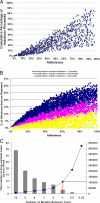The paradoxical effects of using antiretroviral-based microbicides to control HIV epidemics
- PMID: 18606986
- PMCID: PMC2447864
- DOI: 10.1073/pnas.0711813105
The paradoxical effects of using antiretroviral-based microbicides to control HIV epidemics
Erratum in
- Proc Natl Acad Sci U S A. 2009 Apr 21;106(16):6879
Abstract
Vaginal microbicides, designed to prevent HIV infection in women, are one of the most promising biomedical interventions. Clinical trials of second-generation microbicides have begun; if shown to be effective, they could be licensed within 5-10 years. Because these microbicides contain antiretrovirals (ARVs), they could be highly effective. However, there is concern that, if used by HIV-positive women, ARV resistance may evolve. By analyzing a mathematical model, we find that adherence could have both beneficial and detrimental effects on trial outcomes. Most importantly, we show that planned trial designs could mask resistance risks and therefore enable high-risk microbicides to pass clinical testing. We then parameterize a transmission model using epidemiological, clinical, and behavioral data to predict the consequences of wide-scale usage of high-risk microbicides in a heterosexual population. Surprisingly, we show that reducing a participant's risk of resistance during a trial could lead to unexpectedly high rates of resistance afterward when microbicides are used in public health interventions. We also find that, paradoxically, although microbicides will be used by women to protect themselves against infection, they could provide greater benefit to men. More infections in men than in women will be prevented if there is a high probability that ARVs are systemically absorbed, microbicides are less than approximately 50% effective, and/or adherence is less than approximately 60%. Men will always benefit more than women in terms of infections prevented per resistant case; but this advantage decreases as the relative fitness of drug-resistant strains increases. Interventions that use ARV-based microbicides could have surprising consequences.
Conflict of interest statement
The authors declare no conflict of interest.
Figures


Comment in
-
Predicting the unpredictable real-world impact of ARV-based microbicides.Proc Natl Acad Sci U S A. 2008 Nov 4;105(44):E73; author reply E74. doi: 10.1073/pnas.0807633105. Epub 2008 Oct 30. Proc Natl Acad Sci U S A. 2008. PMID: 18974215 Free PMC article. No abstract available.
Similar articles
-
Clinical development of microbicides for the prevention of HIV infection.Curr Pharm Des. 2004;10(3):315-36. doi: 10.2174/1381612043386374. Curr Pharm Des. 2004. PMID: 14754390 Review.
-
Specific microbicides in the prevention of HIV infection.J Intern Med. 2011 Dec;270(6):509-19. doi: 10.1111/j.1365-2796.2011.02454.x. Epub 2011 Oct 27. J Intern Med. 2011. PMID: 21917029 Review.
-
Women and ARV-based HIV prevention - challenges and opportunities.J Int AIDS Soc. 2014 Sep 8;17(3 Suppl 2):19356. doi: 10.7448/IAS.17.3.19356. eCollection 2014. J Int AIDS Soc. 2014. PMID: 25224621 Free PMC article.
-
Should microbicides be controlled by women or by physicians?Int J Infect Dis. 2010 Sep;14 Suppl 3:e14-7. doi: 10.1016/j.ijid.2010.02.2256. Epub 2010 Jun 17. Int J Infect Dis. 2010. PMID: 20932483 Review.
-
Attitudes towards new HIV biomedical prevention technologies among a cohort of HIV-negative gay men in Sydney, Australia.HIV Med. 2010 Apr;11(4):282-8. doi: 10.1111/j.1468-1293.2009.00777.x. Epub 2009 Dec 8. HIV Med. 2010. PMID: 20015220
Cited by
-
Microbicides in the prevention of HIV infection: current status and future directions.Drugs. 2010 Jul 9;70(10):1231-43. doi: 10.2165/10898650-000000000-00000. Drugs. 2010. PMID: 20568831 Review.
-
Predicting the unpredictable real-world impact of ARV-based microbicides.Proc Natl Acad Sci U S A. 2008 Nov 4;105(44):E73; author reply E74. doi: 10.1073/pnas.0807633105. Epub 2008 Oct 30. Proc Natl Acad Sci U S A. 2008. PMID: 18974215 Free PMC article. No abstract available.
-
Analytic review of modeling studies of ARV Based PrEP interventions reveals strong influence of drug-resistance assumptions on the population-level effectiveness.PLoS One. 2013 Nov 25;8(11):e80927. doi: 10.1371/journal.pone.0080927. eCollection 2013. PLoS One. 2013. PMID: 24282559 Free PMC article. Review.
-
A perspective on progress and gaps in HIV prevention science.AIDS Res Hum Retroviruses. 2012 Nov;28(11):1373-8. doi: 10.1089/aid.2012.0277. AIDS Res Hum Retroviruses. 2012. PMID: 22966871 Free PMC article.
-
Degradable bioadhesive nanoparticles for prolonged intravaginal delivery and retention of elvitegravir.Biomaterials. 2017 Nov;144:144-154. doi: 10.1016/j.biomaterials.2017.08.029. Epub 2017 Aug 15. Biomaterials. 2017. PMID: 28829952 Free PMC article.
References
-
- Shattock RJ, Moore JP. Inhibiting sexual transmission of HIV-1 infection. Nat Rev Microbiol. 2003;1:25–34. - PubMed
-
- Veazey RS, et al. Prevention of virus transmission to macaque monkeys by a vaginally applied monoclonal antibody to HIV-1 gp120. Nat Med. 2003;9:343–346. - PubMed
-
- Joint United Nations Programme on HIV/AIDS (UNAIDS) Report on the Global AIDS Epidemic. Geneva: Joint United Nations Programme on HIV/AIDS; 2006. - PubMed
-
- D'Cruz OJ, Uckun FM. Clinical development of microbicides for the prevention of HIV infection. Curr Pharm Des. 2004;10:315–336. - PubMed
Publication types
MeSH terms
Substances
Grants and funding
LinkOut - more resources
Full Text Sources
Medical

